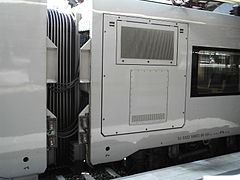| X40 | |
|---|---|
 X40 at
Eskilstuna | |
| In service | 2006–present |
| Manufacturer | Alstom |
| Built at | Salzgitter, Lower Saxony, Germany |
| Family name | Coradia Duplex |
| Constructed | 2004–2008 |
| Number built | 43 |
| Formation | 2 cars (16 units) 3 cars (27 units) |
| Fleet numbers | 3301-3343 |
| Capacity | 153 (2 cars) 252 (3 cars) |
| Operators | SJ |
| Depots | Hagalund |
| Specifications | |
| Train length | 55,100 mm (180 ft 9 in) (2 cars) 81,500 mm (267 ft 5 in) (3 cars) |
| Maximum speed | 200 km/h (125 mph) |
| Weight | 140 t (137.8 long tons; 154.3 short tons) (2 cars) 205 t (202 long tons; 226 short tons) (3 cars) |
| Power output | 1,600 kW (2,100 hp) (2 cars) 2,400 kW (3,200 hp) (3 cars) |
| Electric system(s) | 15 kV 16.7 Hz AC catenary |
| Current collector(s) | Pantograph |
| Safety system(s) | ATC-2 |
| Track gauge | 1,435 mm (4 ft 8+1⁄2 in) |
The X40 is a series of electric multiple units operated by SJ of Sweden. They are in service from Stockholm to Linköping, Västerås/ Örebro, Uppsala and Gävle/ Sandviken, and since 2010 to Gothenburg via Västerås. The double decker trains were built by Alstom from 2004–2008, with 43 units being delivered, either in a two-car or three-car configuration. It is based on the Coradia series, very similar to the French SNCF Class Z 26500 double decker trains, and similar to the X60-series.
The X40 is the first true double-decker train to operate in Sweden, although the first and last cars of the Y3 were built in a style similar to dome cars, connected to single-deck coaches. From 2019 onwards the bilevel Stadler DOSTO will also be used in the Mälardalen and Uppsala regions of Sweden.
Among crew and technical support the vehicle early got nicknamed "Flodhäst", in English "Hippo - big, gray and unpredictable".
Specifications
The double deckers have a little higher passenger capacity than conventional cars, with 85 compared to 78 seats. Wider doors allow the trains to make only 30 second stops in smaller stations and 60 second stops in larger stations. Top speed is 200 km/h (125 mph). Often the trains are paired, with one two-car and one three-car unit. The X40 has both first and second class, but with the same level of comfort. There is air conditioning, signal boosting for mobile telephones, electrical plugs at each chair, that is also equipped with radio. WLAN is available for free to all passengers.
There were many technical problems during the first year of operation in 2006, including problems with doors and the air conditioning. Complaints from passengers were that there was too little room for baggage and that the seat pitch was insufficient. These problems have been addressed through rebuilding the interior, which also included removing all vending machines and coffeemakers from the trains themselves. The trains are specified for regional commuter traffic, and some complaints come from passengers on longer journeys. For example, a common route for the train is Gävle-Stockholm-Linköping, with stop at Arlanda Airport, which means that tourists with heavy luggage use the train. During 2011 they have been used for even longer distances, like Stockholm-Örebro-Göteborg and Stockholm-Sundsvall, which has added to these complaints. In 2012, the new SJ 3000 have replaced the X40 on the Stockholm-Sundsvall line.
External links
-
 Media related to
Alstom X40 at Wikimedia Commons
Media related to
Alstom X40 at Wikimedia Commons - Järnväg.net on X40 (in Swedish)


